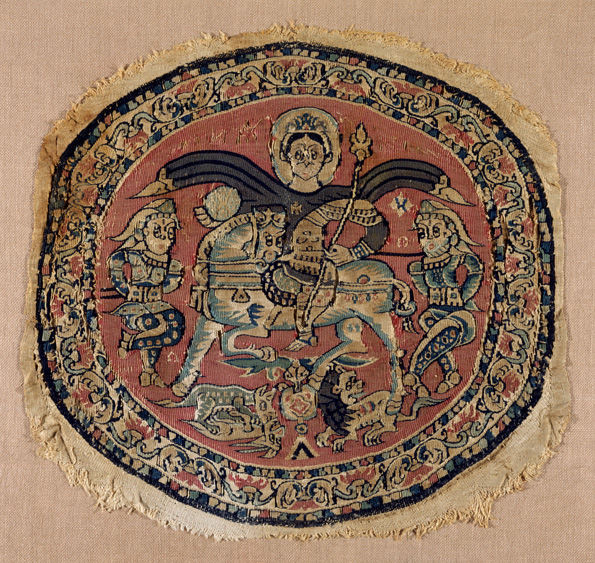The tradition of inscribed textiles in the Islamic world dates to the passing of the Prophet Muhammad (632 A.D.), whose spiritual and political authority was transferred through the donning of his mantle. The newly formed Muslim state experienced a number of shifts in the political arena. New allegiances were often represented by epigraphic bands on textiles, particularly garments. The practice of representing one's allegiance by including images of rulers on garments existed during the later Sasanian period in Iran, as well as in the corresponding Byzantine period, as in the example below. In the emerging context of Islam, texts replaced images.
Roundel with a Byzantine Emperor, Probably Heraclius, 8th century. Made in Egypt, possibly Panopolis (Akhmim). Tapestry weave in red, pale brown, and blue wools and undyed linen on plain-weave ground of undyed linen. Victoria and Albert Museum, London (T.794-1919)
Thereafter, in the Islamic world, honorific garments—or khil'a, in Arabic—served the dual purpose of proclaiming one's allegiance and representing a ruler's mark of of honor. The textiles for these robes of honor were generally produced in royal workshops, which used precious materials such as silk and gold-wrapped thread to weave and embroider inscriptions. The workshops and the textiles they produced are referred to in general as "tiraz," originating from the Persian word for embroidery, tarazin.
Fragment from a Turban with a Tiraz Inscription, late 10th century. Made in Egypt, Tinnis. Plain weave in blue linen with inscription in golden yellow silk thread. Benaki Museum, Athens (14997)
As with most fashion trends, the middle classes began to adopt the new style, adding epigraphy to their garments and other textiles to emulate the appearance of royal, honorific-inscribed robes. Many inscriptions on garments were talismanic in nature, and contained either blessings or proverbs to protect the wearer and attract good fortune. Coptic inscriptions on garments serving the same purpose have also been found on fragments from Egypt.
Fragment of a Shawl, 9th–10th century. Made in Egypt, the Fayyum, probably Tutun. Plain weave in polychrome wool with embroidered inscription in dark blue wool and a row of floral designs in dark blue and purplish wool; fringe along one edge. Benaki Museum, Athens (15343)
As the style was emulated beyond the boundaries of the Islamic world, the epigraphy executed in the Kufic calligraphic style is often either illegible or incorrect, lending itself to what art historians refer to as "Pseudo-Kufic" and morphing into a decorative motif of its own, as in this example:
Fragment of a Fringed Shawl, 9th–10th century. Made in Egypt. Tapestry weave in polychrome wool and linen; fringe along one edge. Benaki Museum, Athens (15608)
Sources
Baker, Patricia. Islamic Textiles. London: British Museum Press, 1995.
Schoeser, Mary. World Textiles. New York: Thames & Hudson, 2003.
Stillman, Yadida Kalfon. Arab Dress: A Short History, From the Dawn of Islam to Modern Times. London: Brill, 2000.
Walker, Daniel, and Aimée Froom. Tiraz: Inscribed textiles from Islamic Workshops. New York: Metropolitan Museum of Art, 1992.



